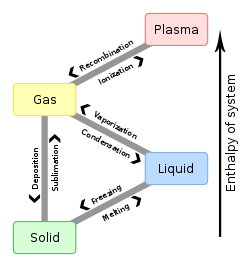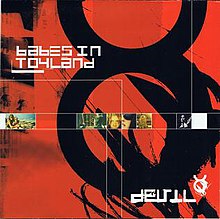스트링 네트 액체
String-net liquid| 표준 모델을 넘어서는 |
|---|
 |
| 표준 모델 |
응집물질 물리학에서 끈망(string-net)은 마이클 A에 의해 위상 질서를 위한 물리적 메커니즘으로 집단 행동을 제안한 확장된 물체이다. 레빈과 원샤오강.특정 스트링 네트워크 모델에는 클로즈드 루프만 포함되거나, 일부 게이지 그룹에 의해 주어진 분기 규칙을 따르는 지향성, 라벨이 부착된 스트링의 네트워크 또는 더 일반적인 [1]네트워크만 포함될 수 있습니다.
개요
현망 모델은 광자, 전자 및 U(1) 게이지 전하의 파생, 작지만 0이 아닌 질량, 그리고 렙톤, 쿼크 및 글루온이 같은 방식으로 모델링될 수 있다는 제안을 보여준다고 주장됩니다.즉, 실망 응축은 광자와 전자(또는 게이지 보손과 페르미온)의 통일된 기원을 제공합니다.빛과 전자(또는 게이지 상호작용과 페르미 통계)의 기원으로 볼 수 있습니다.그러나 이들 모델은 표준 모델에서 페르미온과 SU(2) 게이지 보손 사이의 키랄 결합을 설명하지 않습니다.
양의 정수로 표시된 문자열의 경우, 문자열망은 루프 양자 중력에서 연구되는 스핀 네트워크입니다.이것은 레빈과 웬,[2] 그리고 스몰린, 마르코풀루, 코놉카에[3] 의해 양자 중력의 회전망이 페르미 통계와 게이지 상호작용과 함께 이 메커니즘을 통해 소립자 물리학의 표준 모델을 만들어 낼 수 있다는 제안으로 이어졌다.현재까지 LQG의 스핀 네트워크에서 Levin과 Wen의 스핀 격자로의 엄격한 유도는 아직 이루어지지 않았지만, 이를 위한 프로젝트는 양자 그래피티라고 불리며, 보다 최근의 논문에서 Tomasz Konopka, Fotini Markopou, Simone Severini는 스핀 네트워크와 정확히 유사한 것이 있다고 주장했다(반드시 동일하지는 않다).스트링 네트 [4]메커니즘에서 U(1) 게이지 전하 및 전자까지 상승합니다.
Herbertsmithite는 스트링 네트 [5][6]물질의 한 예입니다.
예
Z2 스핀액
슬레이브 입자 접근법을 사용하여 얻은 Z2 스핀 액체는 스트링 네트 [7][8]액체의 첫 번째 이론적인 예가 될 수 있다.
토릭 코드
토릭 코드는 양자 오류 수정 코드 역할을 하는 2차원 스핀 래티스입니다.각 링크에 스핀 1/2가 있는 토릭 경계 조건을 가진 2차원 격자에 정의됩니다.표준 토릭 코드 Hamiltonian의 접지 상태는 폐쇄 문자열 [9]상태의 등가중 중첩임을 보여줄 수 있다.이러한 지면 상태는 위의 Z2 스핀 액체와 동일한 위상 순서를 갖는 끈망 응축수의[10] 예입니다.
레퍼런스
- ^ Levin, Michael A. & Xiao-Gang Wen (12 January 2005). "String-net condensation: A physical mechanism for topological phases". Physical Review B. 71 (45110): 21. arXiv:cond-mat/0404617. Bibcode:2005PhRvB..71d5110L. doi:10.1103/PhysRevB.71.045110. S2CID 51962817.
- ^ Levin, Michael; Wen, Xiao-Gang (2005). "Photons and electrons as emergent phenomena". Rev. Mod. Phys. 77: 871–879 [878]. arXiv:cond-mat/0407140. doi:10.1103/RevModPhys.77.871. S2CID 117563047.
loop quantum gravity appears to be a string net condensation ...
- ^ Konopka, Tomasz; Markopoulou, Fotini; Smolin, Lee (2006). "Quantum Graphity". arXiv:hep-th/0611197.
We argue (but do not prove) that under certain conditions the spins in the system can arrange themselves in regular, lattice-like patterns at low temperatures.
- ^ Konopka, Tomasz; Markopoulou, Fotini; Severini, Simone (May 2008). "Quantum graphity: A model of emergent locality". Phys. Rev. D. 77 (10): 19. arXiv:0801.0861. Bibcode:2008PhRvD..77j4029K. doi:10.1103/PhysRevD.77.104029. S2CID 6959359.
The characterization of the string-condensed ground state is difficult but its excitations are expected to be that of a U(1) gauge theory, ... The two main differences between this model and the original string-net condensation model proposed by Levin and Wen are that in the present case the background lattice is dynamical and has hexagonal rather than square plaquettes.
- ^ Bowles, Claire. "Have researchers found a new state of matter?". Eureka Alert. Retrieved 29 January 2012.
- ^ Merali, Zeeya (2007-03-17). "The universe is a string-net liquid". New Scientist. 193 (2595): 8–9. doi:10.1016/s0262-4079(07)60640-x. Retrieved 29 January 2012.
- ^ Read, N.; Sachdev, Subir (1 March 1991). "Large-Nexpansion for frustrated quantum antiferromagnets". Physical Review Letters. American Physical Society (APS). 66 (13): 1773–1776. Bibcode:1991PhRvL..66.1773R. doi:10.1103/physrevlett.66.1773. ISSN 0031-9007. PMID 10043303.
- ^ 원자강, 에너지 갭이 유한한 스핀 액체 상태의 평균장 이론과 위상 순서, 물리. 개정판 B44, 2664(1991)
- ^ Kitaev, Alexei, Y.; Chris Laumann (2009). "Topological phases and quantum computation". arXiv:0904.2771 [cond-mat.mes-hall].
- ^ Morimae, Tomoyuki (2012). "Quantum computational tensor network on string-net condensate". Physical Review A. 85 (6): 062328. arXiv:1012.1000. Bibcode:2012PhRvA..85f2328M. doi:10.1103/PhysRevA.85.062328. S2CID 118522495.



